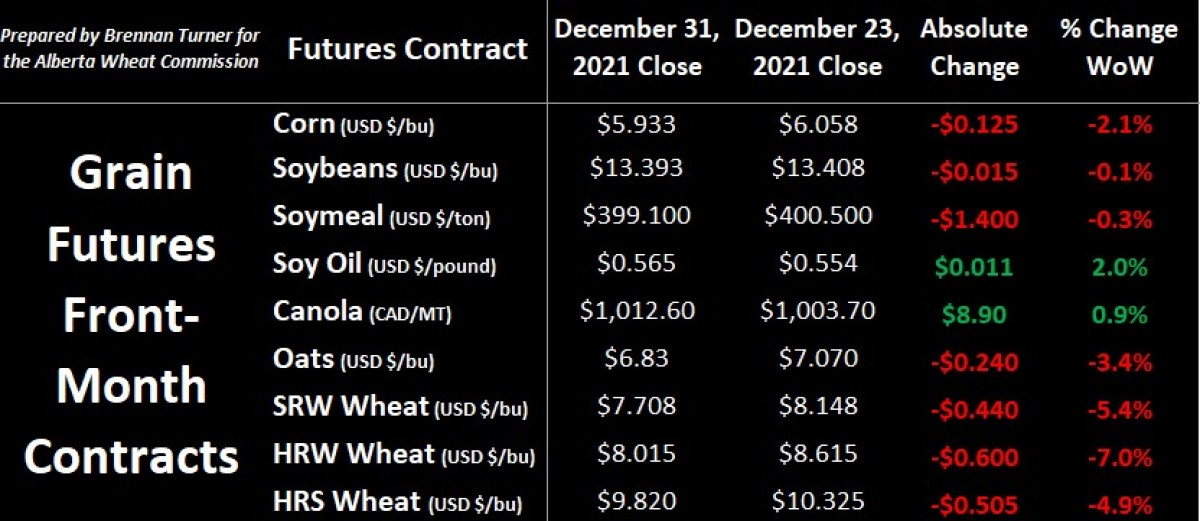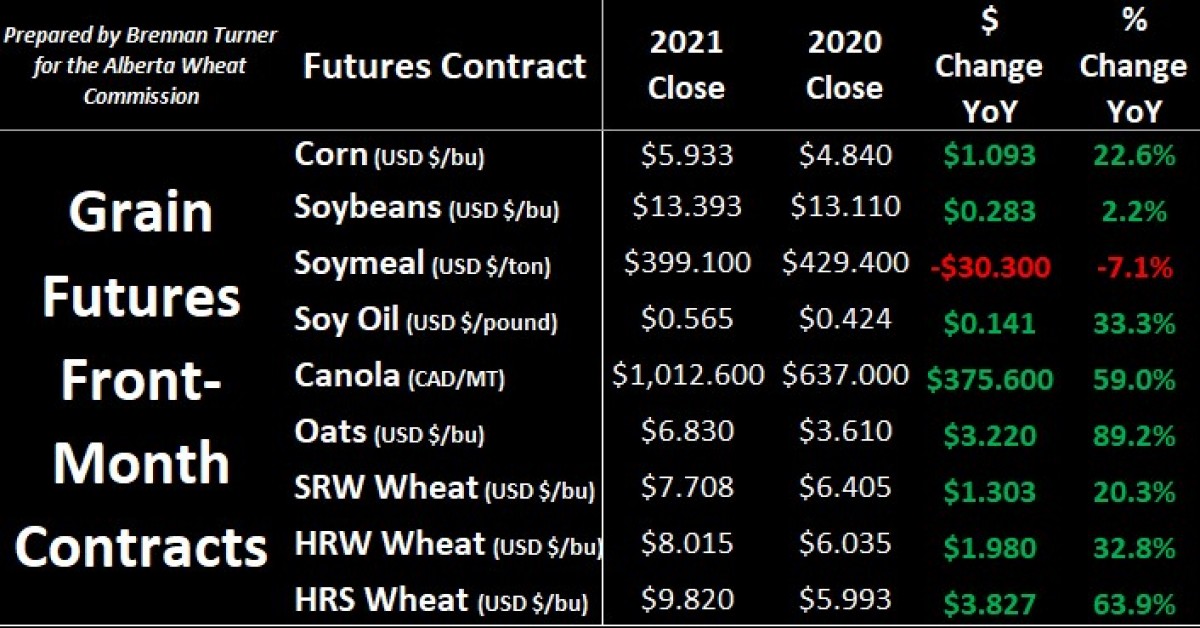When to Price 2022 New Crop Wheat?
Grain markets saw a sell-off that was largely attributed to profit-taking throughout the last week of 2021 on some bearish headlines. Rain falling in parts of Brazil and Argentina that needed it, the de-escalation of the Ukrainian-Russian border conflict, and lack of market of participants to help hold up the market all supported the sell-off. Regardless, supply and demand fundamentals haven’t changed much, and so we’re likely seeing some re-positioning after last week’s drawdown. While this one-week activity is relevant to note, our attention in this week’s Wheat Market Insider will be focused on new crop 2022 pricing (along with a few charts to help visualize things).

Before digging into where we’re going in 2022, compared to where we were a year ago, oats have been the best-performing commodity on the futures boards, ending the year nearly 90% higher than where they started. Coffee was second, up 76% year-over-year, while two Western Canadian staples, HRS wheat and canola, were third and fourth respectively, up 64% and nearly 60% from where 2021 started. On the flipside, soybean meal was the worst-performing agricultural commodity, down 7% year-over-year, while palladium was the worst-performing out of any commodities, down about 22% on the year.

Moving over to 2022, as mentioned last week, there are some tailwinds that are carrying over into the new calendar year, but understanding how new crop wheat prices have performed over the first 9 months is a healthy exercise to go through. Thus, it might be worth saving or bookmarking this column to refer to in the months to come!
First off, durum prices continue to be elevated, and it’s likely that they’ll stay up here until we understand more about Plant 2022 acreage intentions and how the North African harvest does. We’ll likely see a healthy bump in durum acres here in North America, with HRS wheat or even malt barley being replaced where possible. Looking over the past few years, we haven’t seen too much variability in new crop durum prices from the start of a new calendar year to harvest delivery (September), except over the summer when production potential is still up in the air, or at harvest time when first yield and quality reports start to come in.

With that said, where prices for durum (and many other crops) end up next fall will likely be a function of the moisture that the U.S. Northern Plains and Western Canada receive this year. Accordingly, before I plant anything, I’m probably comfortable locking in 10% - 15% of “average” expected production, with opportunities ranging around the $13 CAD/bushel level in most places. To perhaps calm down the bullish side of your brain, a healthy exercise is to ask yourself, “how many times have I priced $13 durum before seeding?”
One other crop that may earn more Western Canadian acres in 2022 is low-protein/CPS wheat. As mentioned last week, CPS wheat prices had one heck of a rally in 2021, largely thanks to basis levels climbing to record levels (and continue to do so with $4 basis in Alberta for spot movement being offered last week). From a new crop pricing standpoint though, non-drought years suggest the best new crop basis can usually be found in late May/early June, when there is still some concern about crop potential. However, it’s important to keep in mind that CPS wheat prices in Western Canada are priced off the Kansas City HRW wheat futures market.

While last year’s average new crop cash CPS wheat price in Western Canada just kept pushing higher, the late May/early June period also seems to be consistently a good time to lock in a contract. Something to remember (and mentioned last week) though is that KC wheat futures tend to pull back in February/March as the condition of the U.S. winter wheat crop comes of out dormancy in an adequate state (usually). Given the current drought conditions in major U.S. winter wheat-producing areas though, speculators could drive future values higher in the next few weeks.

Incredibly though, today, almost anywhere in Western Canada, you can lock in a new crop CPS wheat cash contract for $9 CAD/bushel, which includes $1 of basis. As the charts above show, apart from the tail end of last year’s growing season, this is the best new crop basis and cash level we’ve seen for CPS wheat in Western Canada. From my vantage point though, the best new crop pricing option for CPS wheat is to lock in some basis and price the futures any time between now and delivery in the fall (AKA the next 8 months!)
For HRS wheat, average basis levels in Western Canada for September 2022 delivery are sitting around $1.25 CAD/bushel, with net cash prices totaling $10.30. Like CPS wheat, compared to the last few years, this new crop HRS wheat basis is among the highest it’s been, including throughout last year’s growing season. Similarly, cash HRS wheat prices for September delivery have only seen these heights towards the end of 2021 growing season.


Ultimately, with HRS wheat acres in both the U.S. and Canada likely pulling back a bit, futures values in Minneapolis could remain elevated through to the mid-way point of the upcoming 2022 growing season (or when there is more certainty of what Harvest 2022 will produce). Conversely (and as mentioned in last week’s Wheat Market Insider), the weather that the U.S. Southern Plains see over the next month or so could have a serious impact on futures values. Persistently dry conditions in the region throughout January 2008 were a major reason why the wheat futures market, notably HRS wheat, hit record highs. Therefore, like CPS wheat, locking in the basis today on 10% - 15% of your forecasted 2022 HRS wheat production is a healthy play, with the next 8 months available to you to price the futures out.

To repeat myself from last week, if negative weather forecasts do materialize for American winter wheat regions, I don’t think we’ll touch the records of 2008 but there should be some heavy moves to the upside. If the weather isn’t very bullish, then winter wheat futures will pull back a bit before international buying of the dip helps level things off (plus, keep in mind the Russian wheat export issues!). On the flipside, HRS wheat futures, with its forecasted tight carryover of supplies, should remain elevated, at least compared to years past. Any way you paint it though, new crop pricing opportunities for Canadian 2022 wheat are currently much better than any year in recent memory!
To growth!
Brennan Turner
Founder | Combyne.ag
